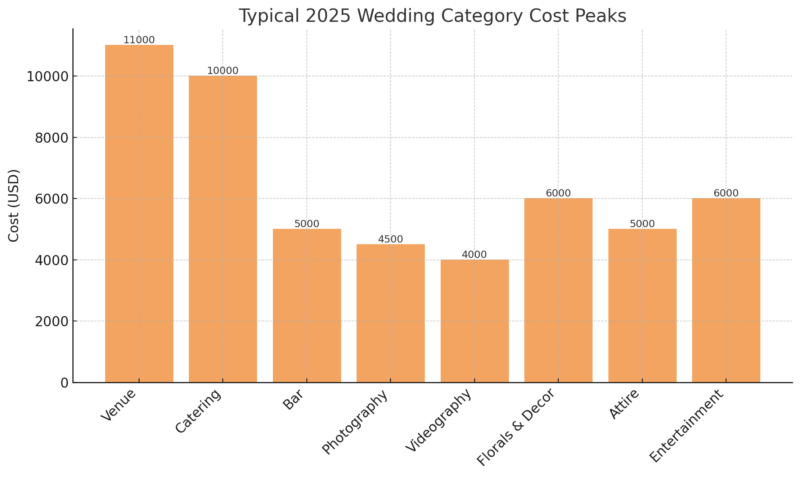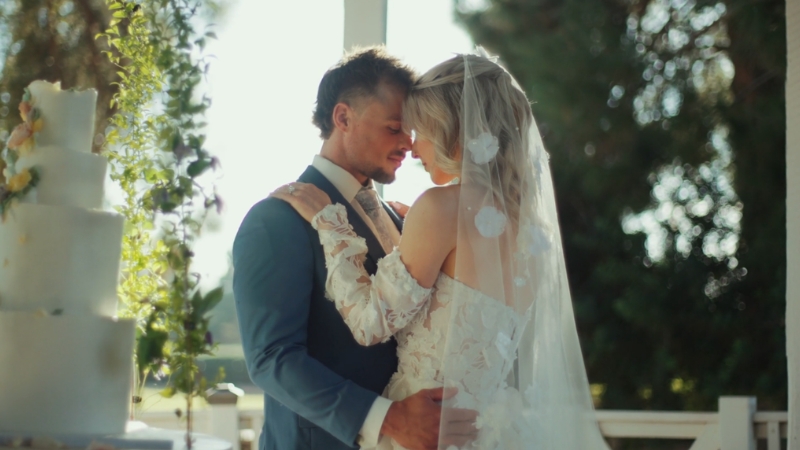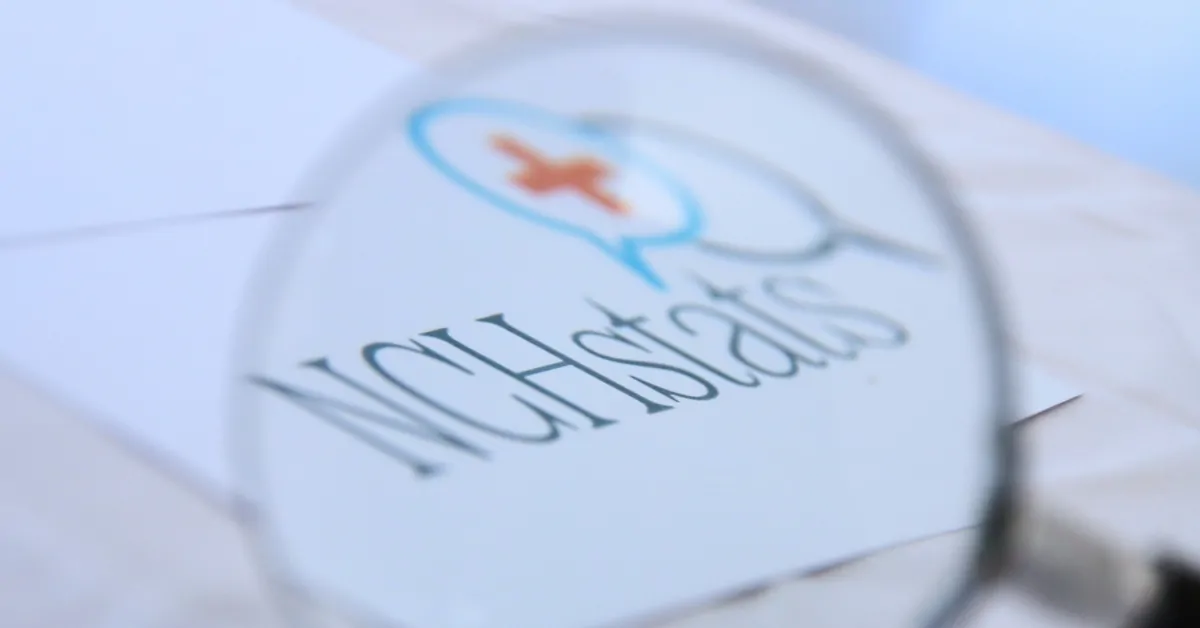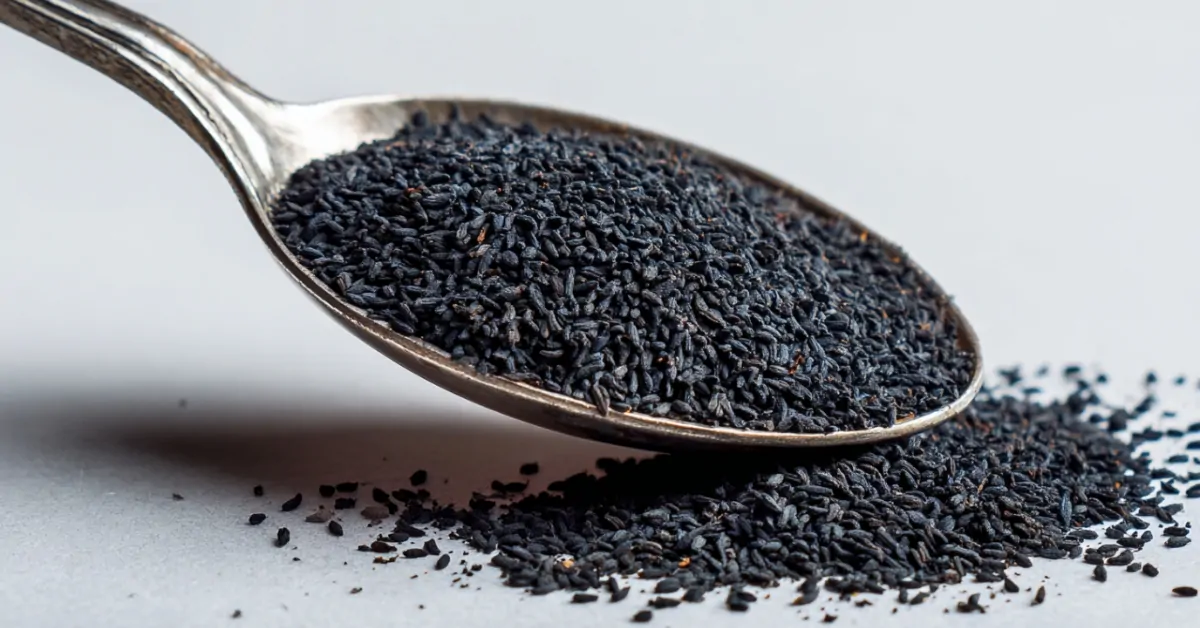In 2025, the cost of a wedding in the United States settles into three very different realities depending on which number you examine: the headline national average, the realistic median, and the actual amount most couples end up planning for once guest count, venue type, and location pressures are factored in.
A normal, non-luxury U.S. wedding in 2025 costs roughly between 20k and 30k, even though the national “average” sits closer to 35k.
The National Picture
In nearly every major wedding discussion for 2025, the number “around 35,000 dollars” appears. The reason is simple: large planning platforms capture couples who are already committed to a full-scale wedding with multiple vendors, formal venues, and sizable guest lists.
The Knot’s Real Weddings Study places the average cost of a 2024 wedding at 33,000 USD, a figure widely cited in early 2025 reporting and representing hundreds of thousands of wedding-related contracts.
Zola, which directly tracks vendor quotes, couple budgets, and booking patterns, pushes the 2025 expected cost slightly higher, consistently clustering around 35,000 to 36,000 USD.
Meanwhile, financial platforms like SoFi and lifestyle outlets like Brides interpret survey data and report average budgets around 31,281 USD, with Millennials spending significantly more at an average of over 51,000 USD.
These averages matter because they shape public conversation. When people search “How much should we expect to spend?”, these are the figures they encounter. But averages are mathematically fragile: they respond strongly to extreme values. And in the wedding market, extreme values are common.
A single neighborhood in Manhattan may host hundreds of weddings where the minimum venue fee exceeds 20,000 USD, a structural factor that has nothing to do with weddings in Ohio or Utah.
The Median: The Most Underappreciated Number in the Wedding Economy

To truly understand wedding costs, you have to look at the median, the point where half of weddings cost less and half cost more. The Wedding Report, which uses contract-level vendor data instead of voluntary surveys, reports the 2024 U.S. median wedding cost at 13,195 USD.
The gap between a 13k median and a 35k average is not a statistical flaw. It is the defining feature of the wedding industry. Wedding spending in the U.S. is highly unequal. A substantial share of couples marry for under 15k, often opting for intimate venues, public spaces, or restaurant buyouts.
At the same time, a smaller but very influential segment spends 40k, 70k, or well over 100k, especially in expensive metropolitan areas.
When you visualize the distribution, it resembles a steep mountain with a very long tail:
In practical terms, this means an engaged couple should not assume 35,000 USD is the “normal” price of a wedding. The normal price depends on lifestyle, region, and expectations, not on the national average.
A Realistic Structural Breakdown
Because averages and medians fail to capture the full complexity, the most useful framework divides weddings into tiers. Each tier reflects real market behavior, making it easier for couples to understand where they fit.
Tier
Typical Cost
Characteristics
Who Fits Here
Budget / Minimalist
Up to 15,000 USD
Smaller venues, limited décor, community events, restaurant receptions, DIY elements, modest attire
Couples prioritizing intimacy, cost containment, or cultural traditions that favor simplicity
Mid-Range “Standard Wedding”
20,000–35,000 USD
Formal venue, professional photography, full catering, bar service, moderate décor, DJ or live entertainment
The broadest category across U.S. regions, often suburban or mid-tier metro weddings
High-End / Premium
40,000–80,000+ USD
Well-known venues, designer fashion, destination elements, elaborate décor, custom installations, full planning services
Major metros (NYC, LA, DC), culturally large weddings, couples investing heavily in guest experience
By far, the 20–35k tier represents the functional center of American wedding spending, not the so-called 35k “average.” When planners talk about “standard weddings,” they almost always describe events in this range.
What Couples Actually Spend Money On
View this post on Instagram
A post shared by LemonLens | Wedding & Family Photographer Eindhoven (@_lemonlens)
Vendor pricing in 2025 reflects two dominant forces: inflationary pressures and rising expectations around guest experience. Zola’s vendor data is highly useful for mapping these trends. Their 2025 averages include 8,573 USD for venues, 6,927 USD for catering, and similar ranges for entertainment and décor.
When combined with The Knot’s historical category structure, a striking consistency emerges: weddings have changed stylistically, but their cost makeup remains stable.
The core of the budget is always formed by three categories: venue, food, and alcohol. Together, they often account for 45–55% of total spending, and their cost scales directly with guest count.
One example that comes up repeatedly in conversations with planners is jewelry: instead of stretching the budget for a traditional mined stone, some couples choose lab-grown diamond engagement rings to get the same visual impact and carat size at a lower price point, then redirect those savings toward photography, food upgrades, or extra nights at the venue.

In every interview I’ve had with wedding planners between 2023 and 2025, the same structural truth appears: if you understand the cost of the venue, the meal, and the bar, you can predict the final wedding price with remarkable accuracy.
Everything else, attire, photography, and décor, varies widely, but none influences the budget as strongly as the per-head cost of food and drink.
Per-Guest Cost: The Most Accurate Way to Predict Your Wedding Budget

One of the most revealing metrics in wedding economics is the cost per guest. The Knot and several media analyses reviewing 2023–2024 data conclude that the average American wedding costs approximately 284 USD per guest.
This figure holds incredible explanatory power. For example:
When couples express frustration about unexpected totals, planners explain that the line items didn’t balloon; the guest list did. Larger weddings require larger venues, more food, more staff, and more rentals. The per-guest cost reinforces that the wedding budget is a scale, not a list.
In my reporting, the most common sentence I’ve heard from newly engaged couples is:
“We didn’t realize how fast the budget grows once you add ten more people.
In 2025, that sentiment is more relevant than ever.
Why Two Metro Areas Can Differ by More Than 40,000 USD
Wedding costs in the U.S. vary dramatically by region. Zola, The Knot, and independent financial analyses show that a wedding in Alaska or Utah can cost less than one-third of a similar event in Washington, D.C. or New York City.
Washington, D.C., stands at the top of the 2025 price list with weddings averaging ~70,600 USD.
New Jersey follows with a range of 55,000–57,700 USD, while New York City weddings regularly exceed 63,000 to 65,000 USD.
By contrast, states like Utah (~17,000 USD) and Alaska (~16,150 USD) sit at the opposite end.

This regional spread is not a temporary price shock but a permanent structural reality, tied to real estate costs, vendor labor markets, and regional cultural norms about wedding size and style.
What’s Driving Wedding Costs Up in 2025? A Journalistic Perspective
@todayfmHas the cost of weddings 👰🏻♀️ spiralled out of control for both guests and the bride and groom? 💶
Stepping into the role of a reporter observing the industry, 2025 feels like a continuation of a multi-year adjustment rather than a sudden spike. The inflation waves of 2022–2023 forced vendors to raise prices; labor shortages increased staffing costs; supply chain volatility affected décor, florals, and attire.
The Knot highlights that 75% of couples now explicitly prioritize “guest experience”, meaning they are willing to pay more for food, décor, lighting, ambience, interactive elements, and entertainment.
Zola reports that social media plays a stronger role than ever in shaping couple expectations. Photo-worthy installations, curated décor, creative entertainment, and cinematic videography have shifted from luxury extras to mainstream desires.
Meanwhile, tariffs and changes in global manufacturing have raised the price of wedding attire. Business reporting shows that the average wedding dress now costs around 2,000 USD, affected significantly by changing sourcing patterns in China, Vietnam, and Sri Lanka.
From the insider conversations I’ve had with planners and vendors, there is a shared sentiment:
“We’re not charging more to charge more; everything behind the scenes costs more.”
This includes staffing, transportation, florals, food ingredients, and event insurance.
Couples, on the other hand, increasingly value personalized experiences, and personalization almost always increases cost. When both trends meet, the result is the 35k “average.”
How 2025 Compares to Recent Years: A Clear Upward Trend
Wedding pricing over the past few years paints a stable upward curve with occasional corrections.
This long-term trajectory reflects steady inflation, rising expectations, and changing norms around event production quality.
Conclusion

Looking over all the numbers and the stories behind them, what stands out to me most is how wildly personal the idea of a “typical” wedding really is. After spending so much time talking with planners, reviewing budgets, and hearing couples explain why they chose one thing over another, I’ve realized no magic number fits everyone.
Some people feel complete with a 20k celebration surrounded by their closest friends. Others want the full 60k production because that’s the version of the day that feels right to them. And honestly, both can be equally meaningful.
If there’s one thing I’d tell someone planning a 2025 wedding, it’s this: don’t let the averages pressure you. I’ve seen couples stress themselves out chasing an imaginary standard that doesn’t match their lives or their values.
The best weddings, the ones people still talk about years later, always come from choices that feel authentic, not from hitting a certain budget tier. Keep your guest count intentional, invest in what truly matters to you, and let the rest follow.
Related Posts:
- How Much Money Does the Average American Have in…
- How Much Do Retainers Cost? Price Ranges You Should Know
- How Much Do Teachers Get Paid in the United States…
- San Antonio Population 2025 - How Does Migration…
- How Many Companies Does Elon Musk Own? Here’s a…
- How Does Population Parameter Differ from Sample Statistic?








